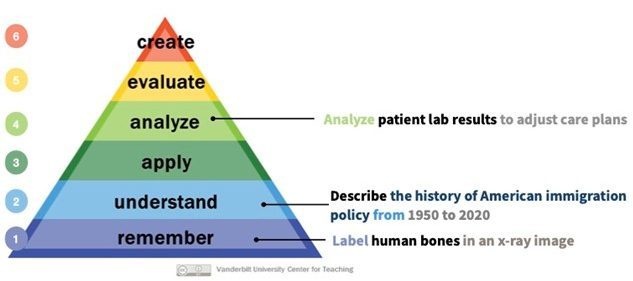Academic programs at the University of Missouri are required to have specific and measurable course learning objectives that define what students should know or be able to do by the end of the course. These course learning objectives should map to program outcomes. This guide is intended for faculty seeking to write or revise course learning objectives.
What is a Course Learning Objective?
Writing clear and measurable course learning objectives is a requirement for alignment. Alignment refers to the ability of a program to articulate how its structure is built upon a series of outcomes and course learning objectives.
If program outcomes are the skills/knowledge gained from a program, then course learning objectives are the skills/knowledge gained from a course.
Course learning objectives are:
- Taught in the Course
- Assessed in the Course
- Specific and Measurable
A course learning objective is taught in the classroom and not outside the context of instruction. They are assessed in the course to ensure students achieve them. Finally, course learning objectives are written to be specific and measurable to ensure effective instruction and assessment.
(Adapted from USC Center for Teaching and Learning, 2023)
Course Learning Objectives are Not Course Topics
Educators can confuse course topics with course learning objectives. Topics are how courses are organized (i.e., the subject being taught and when); they are not observable or assessable.
| Course Topic | Course Objective |
| Human Anatomy | Identify the functions of the major components of the human cardiovascular system. |
Writing Course Learning Objectives
Whether we’re writing program outcomes, course learning objectives, or module/unit/week learning objectives, the format is identical. Our recommended format is:
| Recommended Format | Action Verb + Noun (+condition + timescale) |
When grounded in a learning taxonomy, this format ensures that we keep rigor and assessment in mind.
Examples across the discipline include:
- Analyze Freedom House data in Excel.
- Label human bones in an x-ray image.
- Describe post-treatment care to a patient during an office visit.
- Describe the history of American immigration policy from 1950 to 2020.
- Critique a SWOT Analysis in the tech sector.
- Identify different rhetorical strategies in multidisciplinary texts used in the course.
(Adapted from USC Center for Teaching and Learning, 2023)
Whether program outcomes, course learning objectives, or module/unit/week learning objectives, each statement is prefaced by verb, following a noun and any conditions or timescales. Following this format ensures that the statements can be assessed.
Using a Learning Taxonomy
Grounding course learning objectives in a learning taxonomy helps by (1) ensuring objectives are clear and measurable; (2) articulating alignment to program outcomes; and (3) guiding instructional strategies.
Bloom’s Revised Learning Taxonomy is a recognized learning taxonomy and the recommended taxonomy for academic programs. By organizing course learning objectives into six progressive cognitive levels—remember, understand, apply, analyze, evaluate, and create—it ensures a comprehensive approach to learning that facilitates both foundational knowledge acquisition and the development of higher-order thinking skills. This categorization aids faculty in designing curricula that enhance students’ abilities from basic recall of information to creative problem-solving.
When we add the outcomes/objectives listed above, we see the variety of rigor:

Note that labeling human bones in an x-ray image could be at the lowest level of rigor in Bloom’s taxonomy; describing the history of immigration policy across a series of decades is more rigorous; analyzing patient lab results to adjust care plans is more rigorous than labeling or describing, thus it’s placed at the analyze level.
While we recommend Bloom’s Revised Taxonomy, academic programs may want to consider learning taxonomies, including:
- Fink’s (2003) Taxonomy of Significant Learning
- Marzano and Kendall’s (2007) New Taxonomy of Educational Objectives
How Many Course Learning Objectives Should Each Course Have?
The number of course learning objectives per course varies and is a function of credit hours, discipline, and approach. However, assuming a 3-credit hour course, we recommend a guideline of 4-8 course learning objectives per course. If courses have less than 4 or more than 8, there may be an opportunity to expand or combine course learning objectives, respectively.
Recommendations
The format and wording of a course learning objective affects the degree to which it can be assessed. It is important to be mindful of the following:
- Be careful with the verb “understand” in a course learning objective.
Review the following course learning objective:
“Understand the ethical issues with statistical research.”
“Understand” has two meanings, depending on the context. Understand can refer to mental comprehension of a topic or demonstrating comprehension of the topic. We can only assess the latter. Thus, be cautious if “understand” is the verb in your course learning objective. Consider other verbs grounded in a learning taxonomy.
2. Avoid “use” as an action verb in course learning objectives.
We recommend avoiding “Use” as an action verb. Review the following course learning objective:
“Use Excel to analyze patient data.”
When a course learning objective has “Use” as the action verb, assessment becomes a problem. In the above, a superior action verb already exists. Revised, it reads:
“Analyze patient data in Excel.”
By using “Analyze,” our course learning objective is grounded in a taxonomy, which improves clarity and assessment.
Assistance
For assistance in any aspect of writing program outcomes, please reach out to Jonathan Cisco, Director of Educational Assessment